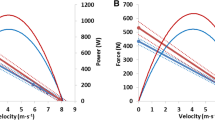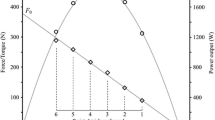Abstract
Purpose
We sought to compare force–velocity relationships developed from unloaded sprinting acceleration to that compiled from multiple sled-resisted sprints.
Methods
Twenty-seven mixed-code athletes performed six to seven maximal sprints, unloaded and towing a sled (20–120% of body-mass), while measured using a sports radar. Two methods were used to draw force–velocity relationships for each athlete: A multiple trial method compiling kinetic data using pre-determined friction coefficients and aerodynamic drag at maximum velocity from each sprint; and a validated single trial method plotting external force due to acceleration and aerodynamic drag and velocity throughout an acceleration phase of an unloaded sprint (only). Maximal theoretical force, velocity and power were determined from each force–velocity relationship and compared using regression analysis and absolute bias (± 90% confidence intervals), Pearson correlations and typical error of the estimate (TEE).
Results
The average bias between the methods was between − 6.4 and − 0.4%. Power and maximal force showed strong correlations (r = 0.71 to 0.86), but large error (TEE = 0.53 to 0.71). Theoretical maximal velocity was nearly identical between the methods (r = 0.99), with little bias (− 0.04 to 0.00 m s−1) and error (TEE = 0.12).
Conclusions
When horizontal force or power output is considered for a given speed, resisted sprinting is similar to its associated phase during an unloaded sprint acceleration [e.g. first steps (~ 3 m s−1) = heavy resistance]. Error associated with increasing loading could be resultant of error, fatigue, or technique, and more research is needed. This research provides a basis for simplified assessment of optimal loading from a single unloaded sprint.



Similar content being viewed by others
Abbreviations
- α :
-
Acceleration
- BM:
-
Body mass
- ES:
-
Cohen’s effect size
- F :
-
Horizontal force
- F aero :
-
Aerodynamic friction force
- F f :
-
Friction force
- F n :
-
Normal force
- F opt :
-
Optimal horizontal force
- F peak :
-
Horizontal force at maximum velocity
- Fv:
-
Horizontal force–velocity relationship
- F 0 :
-
Maximum theoretical horizontal force
- h t :
-
Attachment height of tether to athlete
- L opt :
-
Optimal external normal loading
- m :
-
System mass
- P :
-
Horizontal power
- P max :
-
Maximum horizontal power
- Pv:
-
Horizontal power–velocity relationship
- S Fv :
-
Slope of the linear Fv relationship
- TEE:
-
Typical error of estimate
- v :
-
Horizontal velocity
- v max :
-
Maximum horizontal velocity
- v opt :
-
Optimal horizontal velocity
- v 0 :
-
Maximum theoretical horizontal velocity
- θ :
-
Angle of pull
- μ k :
-
Coefficient of friction
References
Alcaraz PE, Palao JM, Elvira JL (2009) Determining the optimal load for resisted sprint training with sled towing. J Strength Cond Res 23:480–485. https://doi.org/10.1519/JSC.0b013e318198f92c
Arsac LM, Locatelli E (2002) Modeling the energetics of 100-m running by using speed curves of world champions. J Appl Physiol (1985) 92:1781–1788. https://doi.org/10.1152/japplphysiol.00754.2001
Cormie P, McCaulley GO, Triplett NT, McBride JM (2007) Optimal loading for maximal power output during lower-body resistance exercises. Med Sci Sports Exerc 39:340–349. https://doi.org/10.1249/01.mss.0000246993.71599.bf
Cormie P, McGuigan MR, Newton RU (2011) Developing maximal neuromuscular power: Part 2—training considerations for improving maximal power production. Sports Med 41:125–146. https://doi.org/10.2165/11538500-000000000-00000
Cross MR, Brughelli M, Samozino P, Brown SR, Morin JB (2017a) Optimal loading for maximising power during sled-resisted sprinting. Int J Sports Physiol Perform:1–25 https://doi.org/10.1123/ijspp.2016-0362
Cross MR, Brughelli M, Samozino P, Morin JB (2017b) Methods of power–force–velocity profiling during sprint running: a narrative. Rev Sports Med 47:1255–1269. https://doi.org/10.1007/s40279-016-0653-3
Cross MR, Tinwala F, Lenetsky S, Samozino P, Brughelli M, Morin JB (2017c) Determining friction and effective loading for sled sprinting. J Biomech 35:2198–2203. https://doi.org/10.1080/02640414.2016.1261178
Driss T, Vandewalle H (2013) The measurement of maximal (anaerobic) power output on a cycle ergometer: a critical review. Biomed Res Int 2013:589361. https://doi.org/10.1155/2013/589361
Hopkins WG, Marshall SW, Batterham AM, Hanin J (2009) Progressive statistics for studies in sports medicine and exercise science. Med Sci Sports Exerc 41:3–13. https://doi.org/10.1249/MSS.0b013e31818cb278
Jaric S (2015) Force–velocity relationship of muscles performing multi-joint maximum performance tasks. Int J Sports Med 36:699–704. https://doi.org/10.1055/s-0035-1547283
Jaric S (2016) Two-load method for distinguishing between muscle force, velocity, and power-producing capacities. Sports Med. https://doi.org/10.1007/s40279-016-0531-z
Jaskólska A, Goossens P, Veenstra B, Jaskólskp A, Skinner JS (1998) Treadmill measurement of the force–velocity relationship and power output in subjects with different maximal running velocities. Sports Med Training Rehab 8:347–358. https://doi.org/10.1080/15438629909512537
Jimenez-Reyes P, Samozino P, Brughelli M, Morin JB (2016) Effectiveness of an individualized training based on force–velocity profiling during jumping. Front Physiol 7:677. https://doi.org/10.3389/fphys.2016.00677
Kawamori N, Haff GG (2004) The optimal training load for the development of muscular power. J Strength Cond Res 18:675–684. https://doi.org/10.1519/1533-4287(2004)18<675:TOTLFT>2.0.CO;2
Lakomy HKA (1987) The use of a non-motorized treadmill for analysing sprint performance. Ergonomics 30:627–637. https://doi.org/10.1080/00140138708969756
Lockie RG, Murphy AJ, Spinks CD (2003) Effects of resisted sled towing on sprint kinematics in field-sport athletes. J Strength Cond Res 17:760–767. https://doi.org/10.1016/s1440-2440(02)80129-3
Morin JB, Samozino P (2016) Interpreting power-force-velocity profiles for individualized and specific training. Int J Sports Physiol Perform 11:267–272. https://doi.org/10.1123/ijspp.2015-0638
Morin JB, Samozino P, Bonnefoy R, Edouard P, Belli A (2010) Direct measurement of power during one single sprint on treadmill. J Biomech 43:1970–1975. https://doi.org/10.1016/j.jbiomech.2010.03.012
Morin JB, Bourdin M, Edouard P, Peyrot N, Samozino P, Lacour JR (2012) Mechanical determinants of 100-m sprint running performance. Eur J Appl Physiol 112:3921–3930. https://doi.org/10.1007/s00421-012-2379-8
Morin JB et al (2015) Acceleration capability in elite sprinters and ground impulse: push more, brake less? J Biomech 48:3149–3154. https://doi.org/10.1016/j.jbiomech.2015.07.009
Morin JB, Petrakos G, Jimenez-Reyes P, Brown SR, Samozino P, Cross MR (2017) Very-heavy sled training for improving horizontal force output in soccer players. Int J Sports Physiol Perform 12:840–844. https://doi.org/10.1123/ijspp.2016-0444
Petrakos G, Morin JB, Egan B (2016) Resisted sled sprint training to improve sprint performance: a systematic. Rev Sports Med 46:381–400. https://doi.org/10.1007/s40279-015-0422-8
Rabita G, Dorel S, Slawinski J, Sàez-de-Villarreal E, Couturier A, Samozino P, Morin JB (2015) Sprint mechanics in world-class athletes: a new insight into the limits of human locomotion. Scand J Med Sci Sports
Samozino P, Rabita G, Dorel S, Slawinski J, Peyrot N, Saez de Villarreal E, Morin JB (2016) A simple method for measuring power, force, velocity properties, and mechanical effectiveness in sprint running. Scand J Med Sci Sports 26:648–658. https://doi.org/10.1111/sms.12490
Scott BR, Duthie GM, Thornton HR, Dascombe BJ (2016) Training monitoring for resistance exercise. Theory Appl Sports Med 46:687–698. https://doi.org/10.1007/s40279-015-0454-0
Soriano MA, Jimenez-Reyes P, Rhea MR, Marin PJ (2015) The optimal load for maximal power production during lower-body resistance exercises: a meta-analysis. Sports Med 45:1191–1205. https://doi.org/10.1007/s40279-015-0341-8
Spinks CD, Murphy AJ, Spinks WL, Lockie RG (2007) The effects of resisted sprint training on acceleration performance and kinematics in soccer, rugby union, and Australian football players. J Strength Cond Res 21:77–85. https://doi.org/10.1519/R-18145.1
van Ingen Schenau GJ, Jacobs R, de Koning JJ (1991) Can cycle power predict sprint running performance? Eur J Appl Physiol Occup Physiol 63:255–260. https://doi.org/10.1007/bf00233857
Vandewalle H, Peres G, Heller J, Panel J, Monod H (1987) Force–velocity relationship and maximal power on a cycle ergometer: correlation with the height of a vertical jump. Eur J Appl Physiol Occup Physiol 56:650–656. https://doi.org/10.1007/bf00424805
Wilson GJ, Newton RU, Murphy AJ, Humphries BJ (1993) The optimal training load for the development of dynamic athletic performance. Med Sci Sports Exerc 25:1279–1286
Acknowledgements
The authors wish to thank Simon Rogers, Dr Michael McGuigan and Dr Matt Brughelli for their feedback during the development of this manuscript. Matt R. Cross is supported by the New Zealand-France Friendship Fund Excellence scholarship.
Author information
Authors and Affiliations
Contributions
MRC, JBM and PS conceived and designed research. MRC and SRB piloted, and conducted the experiments. MRC performed the analysis and statistical procedures. MRC wrote the manuscript, and all parties read, contributed to review, and gave final approval of the manuscript.
Corresponding author
Ethics declarations
Conflict of interest
The authors declare that they have no conflict of interest.
Additional information
Communicated by Jean-René Lacour.
Rights and permissions
About this article
Cite this article
Cross, M.R., Samozino, P., Brown, S.R. et al. A comparison between the force–velocity relationships of unloaded and sled-resisted sprinting: single vs. multiple trial methods. Eur J Appl Physiol 118, 563–571 (2018). https://doi.org/10.1007/s00421-017-3796-5
Received:
Accepted:
Published:
Issue Date:
DOI: https://doi.org/10.1007/s00421-017-3796-5




